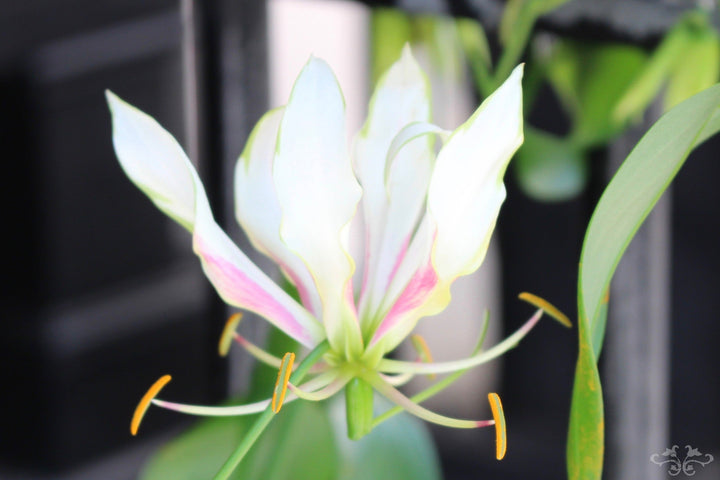
White Gloriosa in Harrods' Rarity Campaign
Harrods are currently hosting a Rarity Campaign, a celebration of the world's best products and experiences, 87 rare finds from jewellery, interiors and beauty to food and... Neill Strain's spectacular white Gloriosa flowers. Following 20 years of dedication, patience and expertise, one Dutch grower has managed to produce 20 bulbs of white Gloriosa, one of the rarest flowers in the world. Now available exclusively at the flower concession at Harrods, Neill explains the incredible story of this exquisite bloom.
Harrods are currently hosting a Rarity Campaign, a celebration of the world's best products and experiences, featuring 87 rare finds from jewellery, interiors and beauty to food, wine and... Neill Strain's spectacular white Gloriosa flowers. Following 20 years of dedication, patience and expertise, one Dutch grower has managed to produce 20 bulbs of white Gloriosa, one of the rarest flowers in the world. Now available exclusively at the flower concession at Harrods, Neill explains the incredible story of this exquisite bloom.

White Gloriosa, featured in Harrods' Rarity Campaign
When Harrods asked me a few months ago if we had a truly rare flower worthy of inclusion in the Rarity Campaign alongside an 18-karat gold-plated Renaissance clock, a signature Rolex watch made of sapphires and diamonds, white pearls Almas caviar, a signed portrait of Albert Einstein, and more astonishing products and experiences, I immediately thought of White Gloriosa. Gloriosa is a relatively new and exclusive bloom in the cut flower market, available in limited quantities of bright shades of red, pink, orange and yellow. A few years ago I once saw a few stems of white Gloriosa which left me spellbound and I knew this would be the perfect Rare Find for Harrods.


Dutch White Gloriosa "Maria" was first discovered in 2008
The entire 2018 production of White Gloriosa "Maria" has been grown exclusively for Harrods Rarity Campaign
Gloriosa plants grow from a single tuber, also called a rhizome, and every year, after flowering, this single tuber becomes a double one which is split into two. Our Dutch breeder and grower, Bennie Ruizendaal, realized that of the 2 tubers from each White Gloriosa plant, one would create red flowers and the other one would create white. Since 2008, every year Bennie has collected the White Gloriosa tubers, some of which have sadly reverted to the original, dominant colour red. This is quite usual in nature and increases the rarity of the white tubers. Today, ten years later, Bennie now has 20 tubers of White Gloriosa which he has planted into 10 pots, producing approximately 10 flowers per plant, 20 per pot. Bennie has allowed us to display these precious plants at our concession at Harrods and the stunning white flowers can be cut and designed for clients upon demand, allowing optimum freshness and the longest vase life (about 5-7 days).




Gloriosa plants grow in the same way as Sweet Peas, i.e. they grow upwards on long, relatively thin, bendy stems and have tentacles, like vines, which they use to attach themselves to as they grow taller. Bennie grows his Gloriosa in his glass house in the north of Holland and the plants reach an optimum height of about 3 meters. Flowers start to bloom on the lower part of the plant and these blooms are sold with their short, fine stems of 15-30 cms. The flowers on the top of the plant can be purchased with several flowers and a stem length up to 1m. These are my favourite because they are so inspiring for design!

Young Gloriosa plants growing, showing their tubers

Gloriosa growing in the nursery showing flowers in bud

Aisles of Gloriosa plants growing tall at the nursery
Our White Gloriosa plants are only 1m tall and you can see them now at Harrods at our concession. Each tuber creates 10 flowers which open gradually, about 1 to 1 1/2 days apart, so the plant will be in bloom for 10-15 days. Gloriosa are sometimes known as Lilies although their flowers do not resemble the Asiatic or Oriental Lilies we know so well. At first, the Gloriosa buds appear to grow upside down and as the petals open they point upwards creating a ball shape, leaving the filaments and the pollen-carrying anthers below.

White Gloriosa "Maria" in bud, with the petals facing downwards



"Maria" Gloriosa flowers opening with her white petals gradually elevating to a vertical position

"Maria" White Gloriosa showing tentacle which attaches onto a support for stability as the plant grows up to 3m tall

"Maria" White Gloriosa flowers blooming on the plant
Bennie and his family have been working with Gloriosa for 48 years and their exceptional flowers are renowned all over the world. Bennie inherited his passion for Gloriosa from his father. For twenty years, Bennie's father ran his own nursery of tomatoes and cucumbers. He acquired some Gloriosa tubers and his intrigue for them led to him to abandoning vegetables and dedicating his nursery solely to Gloriosa in 1970.

Bennie Ruizendaal in his nursery dedicated solely to Gloriosa in north Holland

Because the parent plant was originally red, there are sometimes touches of pale pink at the bottom of the white petals which tend to darken as the flower matures. These features vary from plant to plant and on many occasions the petals have been pure white.

White Gloriosa "Maria" flowering at Neill Strain Floral Couture exclusively for Harrods
The Harrods Rarity Campaign will run until the 16th August. So we still have many plants that will bloom up until this date, after which we will return them to Bennie for flowering next year.



Neill Strain Floral Couture concession at Harrods displaying the White Gloriosa "Maria"
Neill x

"MARIA" WHITE GLORIOSA by NEILL STRAIN FLORAL COUTURE for HARRODS